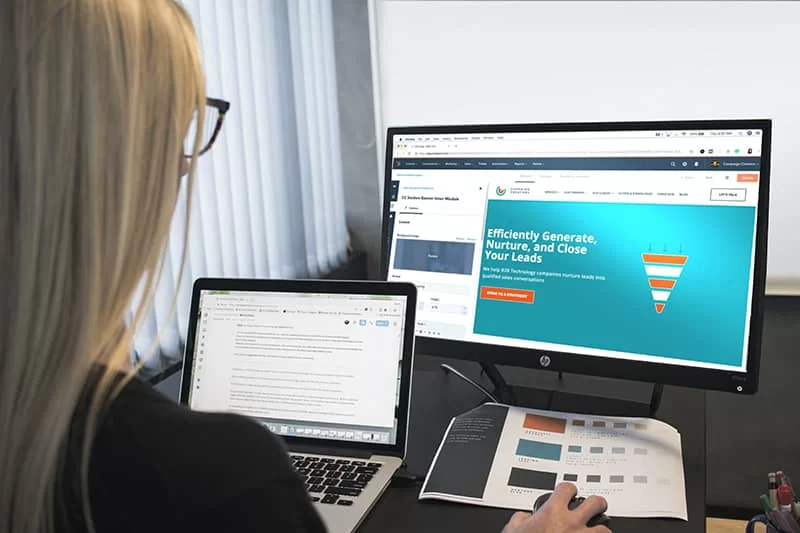15 Exciting Reasons To Use Artificial Intelligence in Web Design

Table of Contents
How To Use Artificial Intelligence in Web Design
Artificial Intelligence (AI) is swiftly carving its niche within the world of web design, heralding a new era of digital innovation. This new technology not only augments the efficiency and creativity of web development but also redefines how user experience is conceptualised and delivered.
In this article, we shall explore the multifaceted impact of AI on web design, from automating mundane tasks to crafting more personalised user experiences, thereby underscoring its pivotal role in shaping the future of web technologies.

1) Enhanced User Experience with AI-Powered Personalisation
User experience (UX) has become a crucial factor in driving customer engagement and satisfaction. With the rise of artificial intelligence (AI) technology, businesses are now able to analyse user behaviour and preferences to personalise their web experience. This process is known as AI-powered personalisation.
So, what exactly is AI-powered personalisation? It refers to the use of AI technology to collect, analyse and utilise data on user behaviour and preferences to provide a tailored experience for each individual. By understanding user needs and interests, businesses can offer relevant content, products or services that are more likely to capture their audience’s attention and lead to increased engagement.
AI-powered personalisation has become a game-changer in the digital world, as it allows businesses to create a one-to-one experience for their users. Instead of bombarding customers with generic content or advertisements, AI-powered personalisation helps deliver a more targeted and personalised approach. This is especially important in today’s competitive market, where customers have high expectations for personalised experiences.
By utilising AI technology, businesses can analyse vast amounts of data in real-time to create a more complete picture of their users’ preferences and needs. This allows for the delivery of highly relevant and timely content, resulting in increased engagement and satisfaction with the web experience.

2) Automated Web Design Processes with AI
As technology continues to evolve, it has become commonplace for businesses and individuals alike to have an online presence in the form of a website. However, creating a visually appealing and functional website can be a time-consuming and expensive process. This is where automated web design processes with AI come in.
Artificial Intelligence (AI) has revolutionised the way web design is done, making it faster, more efficient and cost-effective. With AI, tedious tasks such as layout design, colour selection and content generation can be streamlined, freeing up time for designers to focus on more creative aspects of the website.
AI algorithms can analyse data from existing websites and use this information to automatically generate layouts based on user preferences, saving designers hours of work. AI can suggest colour palettes based on a brand’s logo or theme, ensuring consistency and cohesiveness in the website’s design.
One of the most significant benefits of using AI in web design is its ability to generate content. With Natural Language Processing (NLP) technology, AI can analyse a brand’s tone and style and generate content that resonates with its target audience. This not only saves time but also ensures that the website’s content is tailored to the brand’s voice.
AI can continuously learn and improve its design abilities, making it a valuable tool for businesses looking to stay ahead of their competition. With AI handling repetitive tasks, designers can focus on innovative ideas and bring a unique touch to their designs.

3) Improved Accessibility Through AI Integration
As the world becomes increasingly digital, it is more important than ever to ensure that websites are accessible for people with disabilities. This includes making sure that websites adhere to accessibility standards set by organizations like the World Wide Web Consortium (W3C).
Unfortunately, designing for accessibility can be a complex and time-consuming task, often requiring specialised knowledge and resources. However, advancements in Artificial Intelligence (AI) have made it possible to improve accessibility through integration with web design.
By incorporating AI into the website design process, developers can ensure that their websites meet or even exceed accessibility standards. For example, AI algorithms can be used to automatically generate image descriptions for visually impaired users, making images more accessible. This eliminates the need for manual input and saves time for web designers.
AI can also assist with screen reader compatibility by identifying areas of a website that may cause difficulties for users with visual impairments. This allows developers to make necessary adjustments and create a more inclusive experience for all users.
Another benefit of integrating AI into web design is the ability to generate transcripts or captions for video and audio content, making it more accessible for users with hearing impairments. This not only improves accessibility but also provides a better user experience overall.
Incorporating AI into website design can also benefit users with cognitive disabilities by simplifying navigation and making content more easily understandable. For example, AI can suggest alternative text or summarise lengthy articles to improve comprehension for those with cognitive challenges.

4) Data-Driven Design Decisions Using AI Analytics
Data-driven design decisions refer to the process of using data and analytics to drive design choices. This approach is becoming increasingly important as technology advances and user expectations continue to grow.
One of the most powerful tools in this space is AI analytics, which leverages artificial intelligence algorithms to analyse vast amounts of data. By doing so, it can identify patterns, trends and insights that would be impossible for a human to spot. This makes AI analytics a crucial component in making informed design decisions.
One of the key benefits of AI analytics is its ability to provide accurate and reliable data. Unlike traditional methods of collecting user feedback, such as surveys or focus groups, AI analytics can collect real-time data from users as they interact with a product or service. This allows designers to make decisions based on current, objective data rather than relying on subjective opinions.
AI analytics can uncover hidden insights that may not be immediately apparent to a designer. By analysing user behaviour and interactions, AI algorithms can identify trends and patterns that designers may have overlooked. These insights can then be used to inform design decisions, leading to more user-friendly and engaging experiences.
Another advantage of AI analytics is its scalability. As technology continues to advance, the amount of data available for analysis is increasing exponentially. Traditional methods of data analysis can struggle to keep up with this growth, but AI analytics can easily handle large volumes of data without compromising on accuracy or speed.

5) AI-Powered SEO for Better Search Engine Ranking
There’s no denying that search engine optimisation (SEO) plays a crucial role in increasing your website’s visibility and driving organic traffic. However, with the ever-changing algorithms of search engines like Google, it’s becoming increasingly challenging to keep up with SEO best practices. This is where AI-powered SEO comes in.
AI tools have revolutionised the way we approach SEO by using machine learning algorithms to analyse data and make informed decisions about website content. These tools can help you identify the most relevant keywords, optimize your meta tags and titles, analyse backlink profiles, and even predict future trends in search engine ranking.
But how exactly does AI-powered SEO work? Well, it starts by gathering data from various sources such as search engines, social media platforms, and user behaviour. This data is then used to create a comprehensive understanding of what users are searching for and how they interact with online content.
Next, AI algorithms analyse this data to identify patterns and trends, allowing them to make informed decisions about which keywords, title tags, and meta descriptions will be most effective in boosting your website’s search engine ranking. These tools can also help you identify areas for improvement, such as broken links or duplicate content, and provide recommendations to fix them.
The use of AI-powered SEO not only saves time but also ensures that your website is consistently optimised for search engines. With the help of AI tools, you can stay ahead of the competition by constantly adapting to new SEO trends and algorithm changes.

6) Predictive User Behavior Analysis for Enhanced Engagement
As technology continues to advance, businesses are constantly seeking new and innovative ways to engage their users. One of the latest trends is predictive user behaviour analysis, which uses artificial intelligence (AI) to predict user actions and behaviours.
This type of analysis allows businesses to proactively make design adjustments that increase user engagement and conversion rates. By understanding how users interact with a website or app, businesses can tailor their content and design to better meet the needs of their audience.
Through the use of AI algorithms, predictive user behaviour analysis can gather vast amounts of data on user actions and behaviours. This data is then analysed to identify patterns and trends, allowing businesses to predict what users are likely to do next. This information can be used to make informed decisions on design and content changes to enhance user engagement.
For example, if the analysis shows that users tend to click away from a certain page or form without completing it, businesses can make adjustments to simplify the process and improve conversion rates. By anticipating user behaviour and making proactive changes, businesses can create a more seamless and engaging experience for their users.
In addition to increasing engagement, predictive user behaviour analysis can also help businesses save time and resources. By predicting potential issues or roadblocks, businesses can address them before they become bigger problems. This not only improves the overall user experience but also allows businesses to streamline their processes and improve efficiency.

7) Real-Time Content Optimisation with AI
Having a website on the World Wide Web is no longer enough. With the sheer volume of content available on the internet, businesses need to constantly update and optimise their website to stay relevant and engaging for their target audience.
This is where real-time content optimisation with AI comes into play. By harnessing the power of artificial intelligence, businesses can dynamically update their website’s content based on user interaction. This means that the content displayed to users will be tailored to their specific interests and needs, providing them with a more personalised and engaging experience.
But how does this work exactly? Real-time content optimisation with AI involves using machine learning algorithms to analyse user behaviour and preferences. By tracking things like click-through rates, scroll depth, and time spent on specific pages, AI can determine what content is resonating with users and what isn’t.
Based on this data, the website’s content can be automatically updated and optimised to better suit the needs of its audience. This could include changing the layout of a page, recommending relevant products or articles, or even altering the language used in the content.
The benefits of using AI for real-time content optimisation are numerous. Not only does it save time and resources for businesses, but it also ensures that their website is always up-to-date and relevant to their audience’s interests. This leads to increased engagement, conversions, and ultimately, improved customer satisfaction.

8) Efficient Error Detection and Resolution with AI
The most important areas of efficient error detection and resolution with AI:
- Efficient error detection and resolution is crucial for ensuring a seamless user experience on any website or application.
- With the rapid advancements in technology, AI has emerged as a powerful tool for detecting and resolving errors in web design, saving both time and effort.
- By utilising machine learning algorithms, AI can quickly analyze vast amounts of data and identify potential errors in the design, layout, and functionality of a website.
- This allows for proactive identification of issues before they affect users, avoiding any negative impact on their experience.
- AI also has the capability to automatically fix these errors, reducing the need for manual intervention and saving valuable time.
- With continuous learning capabilities, AI can improve its error detection and resolution processes over time, resulting in a more efficient and reliable system.
- By streamlining this process, AI helps web developers and designers focus on other important aspects of their work, ultimately improving the overall quality and performance of the website.
- AI can also provide valuable insights and recommendations for further improvements to prevent future errors from occurring.
- Overall, efficient error detection and resolution with AI not only ensures a smooth and reliable user experience but also helps businesses save time, resources, and potential losses in revenue due to technical issues.
So, while there is no “end” in sight for advancements in technology and web design, with AI at your disposal, you can rest assured that any errors will be quickly and efficiently resolved. So, incorporating AI into your web design process is not just a trend, but a necessary step towards ensuring a successful online presence. Keep up with the pace of technology and stay ahead of the competition by harnessing the power of AI for efficient error detection and resolution.

9) Scalable Web Design Solutions Powered by AI
Scalable Web Design Solutions Powered by AI refers to the innovative use of artificial intelligence technologies to create flexible, adaptive web designs that can grow and evolve in line with a business’s changing needs.
These solutions leverage AI to analyse user interactions and preferences, enabling the dynamic adjustment of design elements to improve user experience and engagement. This approach not only optimises the website for current users but also anticipates future trends, ensuring the website remains relevant and accessible across various devices and platforms.
The businesses that would focus on this type of technology are typically those with high volumes of web traffic and a need to constantly update their website to keep up with changing customer demands.
One of the key benefits of using scalable web design solutions powered by AI is that they are able to process and interpret large amounts of data in real-time, making changes and improvements on-the-fly. This eliminates the need for manual updates and coding, saving businesses time and resources.

10) Innovative Design Elements Through AI Creativity
Innovative design elements through AI creativity open up a new horizon for art and design, blending computational power with human imagination. AI algorithms can analyse vast datasets of design styles and elements, generating novel and unique designs that push the boundaries of traditional aesthetics.
This fusion of technology and creativity not only accelerates the design process but also introduces a level of personalisation and complexity previously unimaginable, transforming how we conceive and interact with design in every aspect of our lives.
The future of web design is set to be revolutionized by AI and machine learning. With the ability to analyse user data and behaviour, AI can create personalised website experiences tailored to individual users. This goes beyond just basic customisation options, but rather a deep understanding of each user’s preferences, habits, and needs.
One example of this is the use of AI chatbots on websites. These chatbots utilise natural language processing (NLP) to communicate with users and provide a more human-like interaction. They can also analyse user data to predict their needs and offer personalised recommendations or solutions.
AI can assist in the design process by automating tedious tasks such as coding and designing layouts. This not only saves time for designers but also allows for more experimentation and exploration in the creative process. AI can also generate design variations and suggestions, helping designers to consider alternative options and push their boundaries.

11) AI in Enhancing Website Security
AI technologies are revolutionising the realm of website security by identifying and mitigating threats faster than traditional methods. For example, machine learning algorithms can analyse patterns to detect anomalies, potentially identifying security breaches such as DDoS attacks or phishing attempts before they escalate.
AI-driven systems like CAPTCHA and biometric authentication are enhancing the user verification process, making it significantly harder for bots and fraudulent users to gain unauthorised access. This not only protects user data but also ensures the integrity of a website’s content and functionality.
AI technologies are also being used to improve password security. With the use of AI, password managers can analyse patterns and behaviours to create stronger and more unique passwords for users. This reduces the risk of weak or reused passwords being compromised in cyber attacks.
In addition to detecting threats and enhancing user verification, AI technologies are also being used for risk assessment and fraud detection. By analysing vast amounts of data in real time, AI systems can identify suspicious activities and flag them as potential threats.

12) Cost-Effective Web Design with AI Automation
Cost-effective web design with AI automation presents an innovative way to create and maintain websites without the high costs traditionally associated with custom web development. AI tools can now generate designs, suggest content, and even ensure that a website is optimised for search engines, all at a fraction of the time and cost. This approach not only makes web design more accessible but also allows for rapid adjustments based on analytics, ensuring websites remain dynamic and user-focused.
AI Automation in web design has revolutionised the way websites are created and maintained. With AI tools becoming more sophisticated, businesses of all sizes can now benefit from cost-effective web design solutions.
AI automation helps to streamline the web design process, reducing time and resources required for development. With features like drag-and-drop interfaces and pre-designed templates, even those with little technical expertise can easily create a professional-looking website in the matter of minutes!
Content Management Systems (CMS) such as WordPress have plugins that have AI integration to automate tasks such as content creation and SEO optimisation, further reducing the need for manual labour. This not only saves time but also allows businesses to focus on other important aspects of their operations.
AI automation in web design goes beyond just aesthetics. These tools can also gather data and analytics, allowing businesses to understand user behaviour and make informed decisions for website improvements.

13) AI-Driven A/B Testing for Optimal Design Choices
AI-driven A/B testing represents a significant leap in how design choices are optimised, leveraging artificial intelligence to systematically compare different versions of a product or webpage. This approach allows for an in-depth analysis of user interactions, effectively determining which variant yields the best performance in terms of engagement, conversion rates, or any other key metric. By harnessing AI, companies can rapidly iterate on designs, making informed decisions that are backed by data, thus significantly reducing the guesswork involved in creating user-centric designs.
AI-driven A/B testing is a powerful tool in the hands of designers, developers and marketers alike. By leveraging artificial intelligence, companies can gain valuable insights into user behaviour and preferences, enabling them to make data-driven design decisions that ultimately lead to better engagement and conversion rates.
The use of AI in A/B testing also allows for a more efficient approach to improving products or webpages. Traditional A/B testing methods often require a significant amount of time and resources to set up, run and analyse results. However, with AI-driven A/B testing, this process can be automated and accelerated, allowing for faster iteration and improvement cycles.
AI-driven A/B testing is able to handle more complex scenarios and variables compared to traditional methods. With the ability to analyse vast amounts of data, AI can identify patterns and trends that may not be apparent to human analysts. This can lead to more precise and accurate conclusions, resulting in more effective design decisions.

14) Voice Interface Integration Using AI
Voice interface integration using AI enables devices to understand and respond to human speech, revolutionising how we interact with technology. Through advanced algorithms, these systems can comprehend spoken commands, perform tasks, and even engage in conversations. This integration not only simplifies user interactions but also makes technology more accessible, particularly for those who may struggle with traditional input methods.
Examples of AI voice interface integration include virtual assistants like Siri, Alexa, and Google Assistant, which respond to voice commands for tasks such as setting reminders, playing music, and answering questions. AI voice interface integration can be found in smart home devices like thermostats, lighting systems, and security cameras that can be controlled using voice commands.
Voice interface integration using AI has also been implemented in the automotive industry, allowing drivers to use voice commands for navigation, music, and other functions without taking their hands off the wheel. This improves safety and convenience while driving.
In addition to enhancing user experience, AI voice interface integration has also opened up new opportunities for businesses. Companies can now develop personalised virtual assistants for customer support, making interactions more efficient and providing a better overall experience. AI voice interface integration also allows for the automation of tasks, reducing human error and freeing up employees to focus on more complex tasks.
With the continuous advancements in natural language processing and machine learning, the potential for AI voice interface integration is constantly expanding. As more devices become connected and capable of understanding human speech, our daily interactions with technology will continue to evolve.

15) Future-Proofing Web Design with AI
Future-proofing web design involves anticipating and adapting to future changes to ensure that websites remain functional, relevant, and engaging over time. The incorporation of Artificial Intelligence (AI) in web design is a groundbreaking approach that significantly contributes to this aim. AI can analyse user interactions and feedback in real-time, enabling websites to adapt their content, layout, and functionality to meet user needs dynamically. This makes websites more user-centric, improves user experience, and potentially increases engagement and conversion rates.
For example, AI-powered chatbots can provide instant customer support, answering common queries and guiding users through the website, mimicking a human-like interaction. This not only enhances user experience but also saves time and resources for businesses. Furthermore, AI-driven analytics tools can identify trends and patterns in user behaviour, helping web designers make informed decisions about website layout and content. These tools can predict which parts of a website are likely to attract more attention, allowing for optimised placement of critical content and calls to action.
Looking to the future, it’s predicted that AI will play an even larger role in web design. We might see the emergence of fully AI-driven website builders that can create sophisticated and highly customised websites with minimal human input. These AI designers could potentially analyse a brief and then autonomously generate a full website design, complete with optimised user experience and bespoke aesthetic elements. Such advancements could democratise high-quality web design, making it more accessible to smaller businesses and individuals without significant resources.

The Future of Artificial Intelligence in Web Design is Here!
The integration of artificial intelligence into web design is not just an emerging trend but a paradigm shift that is here to stay. From automating mundane tasks to creating highly personalised user experiences, AI is redefining the boundaries of what is possible in web design.
As technology continues to evolve, so will the capabilities of AI in this field, promising a future where web design is more intuitive, efficient, and tailored to meet the diverse needs of users worldwide.
The future of web design, shaped by AI, promises to be an exciting one, teeming with possibilities that were once deemed beyond reach. What are your thoughts of a AI future in web design?
Leave A Comment
Loved this article? Please consider sharing it with your friends…

Peter Lowen
Senior Web Developer | CEO
Peter Lowen is the founder and CEO of Constructive Visual, a website design and hosting company. He has been creating websites since 2005 and writes content on business, marketing, web design, sales training, web hosting and WordPress related topics.
Enjoyed Our Article? We've found a few more for you!
Responsive Web Design – Best Practices for a Responsive Website
In an era where digital presence is imperative, having a responsive website is no longer optional—it’s essential. At Constructive Visual,...
Strengthen your Perth & Wheatbelt business’s online presence with tailored website design and hosting, raising visibility, enhancing user experience, and...
Branding is essential for any business, big or small. It helps to create a unique identity and sets you apart...
Creating a Strong Online Foundation – Small Business Web Design in Perth
In today’s digital age, having a well-designed website is crucial for small businesses in Perth. A professionally designed website can...










